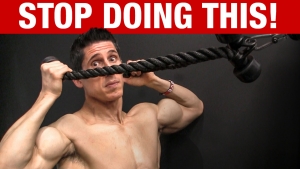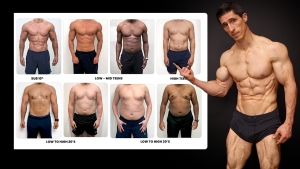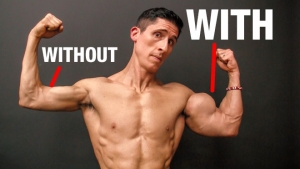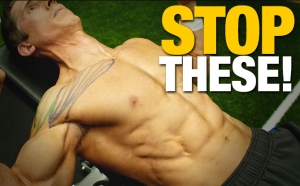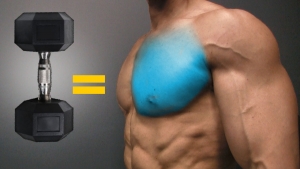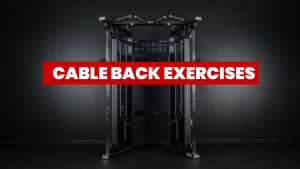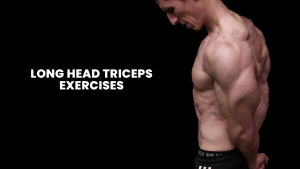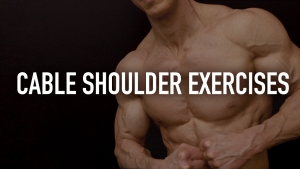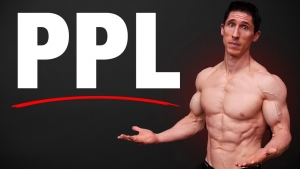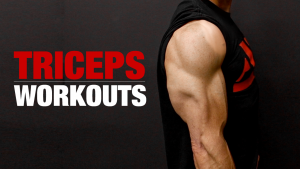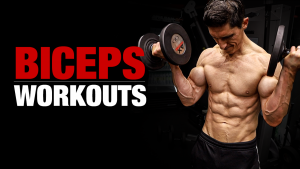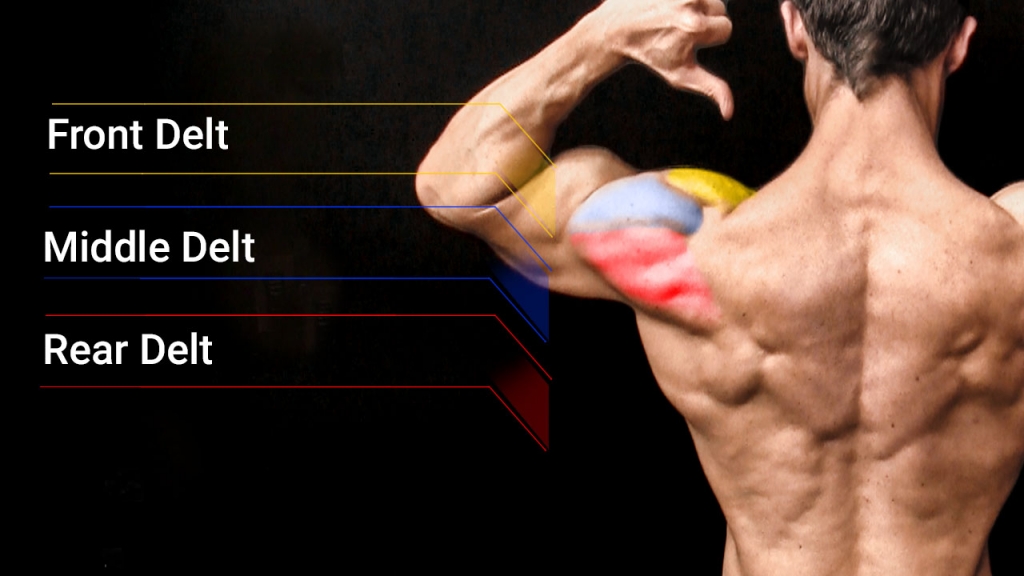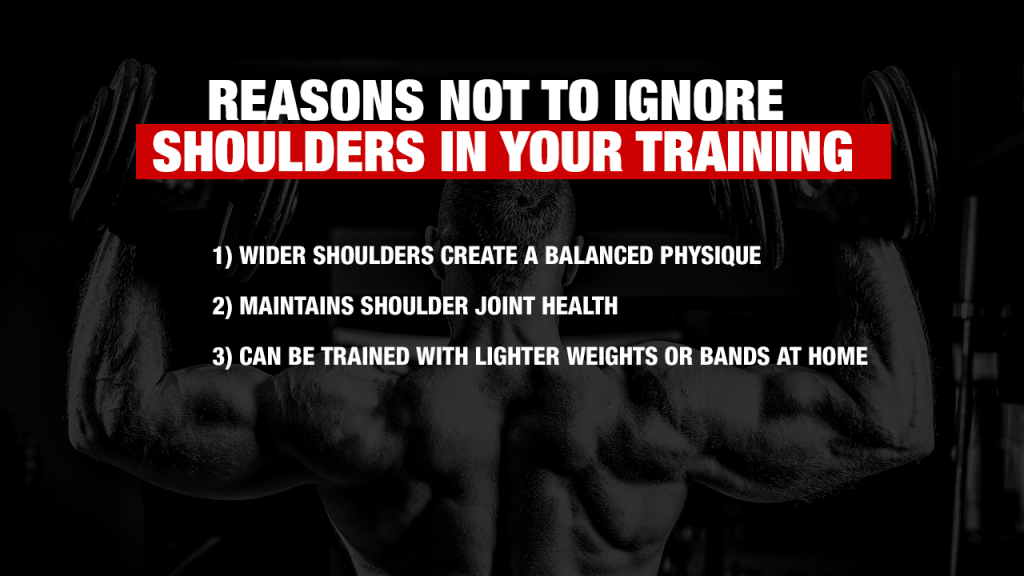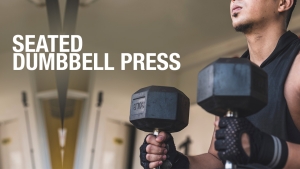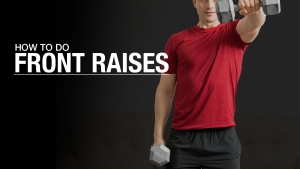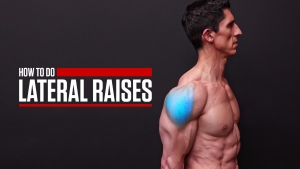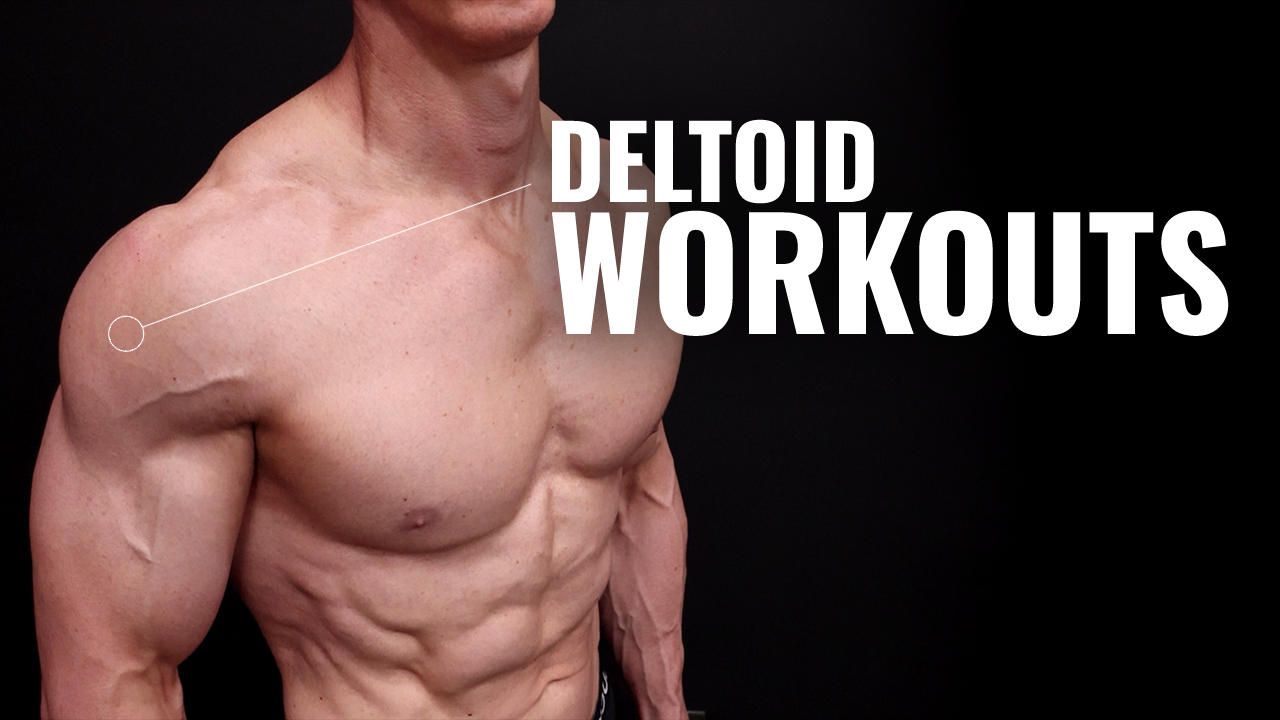
THE ULTIMATE DELTOID WORKOUT GUIDE
Too many of us tend to neglect our deltoids. We either don’t train them enough or we use incorrect techniques.
Although the deltoids might not be your top priority when it comes to muscle building and strength training, it is vital that you don’t overlook them.
In this comprehensive guide to deltoid workouts, I’m going to give you an overview of the shoulder muscles and explain the significance of each deltoid head.
I’m also going to offer you the most effective exercises and workout tips for your deltoids, regardless of the equipment you have on hand. Whether you have a full gym or just your body weight, I’ve got a deltoid workout for you.
What’s more, I’m going to address the most asked questions related to deltoids and shoulder workouts.
Here’s what I’ll cover in this guide on strengthening your deltoids:
1) DELT MUSCLES ANATOMY
Before we explore the optimal exercises for the deltoids, I want to make sure you understand the anatomy of the deltoid muscle.
Why does that matter?
Four words: mind to muscle connection.
The mind-to-muscle connection is all about developing a conscious, focused intent in your fitness routine, where you control every contraction and release of your muscles.
The goal is to truly “feel” the exercise rather than just mechanically perform it.
The stronger your mind-to-muscle connection, the better the contraction and muscle activation.
Speaking of muscles, the deltoid muscle is made up of three main sections, or heads:
- Anterior deltoids
- Lateral deltoids
- Posterior deltoids
Let’s break each one down to better understand their unique roles in upper body movements:
FRONT DELTS (ANTERIOR DELTS)

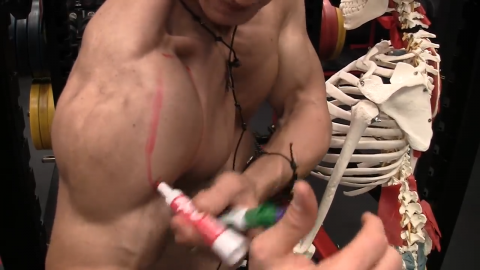
Your anterior deltoids sit at the front of your shoulder, and their primary function are shoulder flexion, or moving your arm forward and upward.
The front delts also aid in horizontal adduction, bringing your arm across your body. Plus, when your arm is by your side, the anterior delt helps internally rotate your arm.
Contrary to popular belief, relying solely on a chest day workout routine to develop well-rounded shoulders isn’t enough. Truly sculpted cannonball shoulders require additional targeted deltoid exercises.
In particular, you’ll want to focus on a combination of compound movements and isolation moves. For example, an Overhead Shoulder Press with a Cable Front Raise.
SIDE DELTS (LATERAL DELTS)

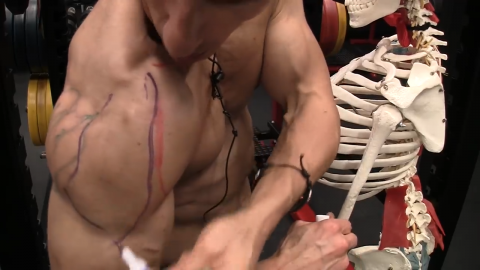
The lateral deltoids, or side deltoids, are the muscle fibers you want to focus on if you want to have that ‘broad shoulders’ look.
The primary function of the lateral delts is to perform shoulder abduction – that is, lifting your arms out to your sides. It’s involved in additional functions including complex movements, like lifting your arm and rotating it when your elbow is at a 90-degree angle.
To target the side delts, I’d recommend side delt exercises like the Rear Delt Row or Abduction Row.
REAR DELTS (POSTERIOR DELTS)

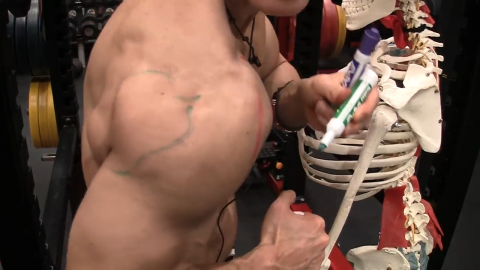
The posterior deltoids, or rear deltoids, are key players in shoulder extension (moving your arm backward), horizontal abduction (moving your arm away from the front of your body in a horizontal plane), and external rotation of your shoulder.
Targeting the rear heads is important to avoid postural distortions and muscle imbalances. After all, you can’t just focus on the front of your shoulders – You need to hit the back too!
Some of the best rear delt exercises include the Seated Rear Delt Row and the Abduction Row. For more rear delt exercises, check out my article on Best Rear Delt Exercises.
2) WHY ARE DELT WORKOUTS IMPORTANT?
I know when most people think about getting in an upper body workout, they tend to think about bigger muscles like Chest Day and Back Day.
You might look at them like a smaller, secondary muscle, but the delts should be treated like a major muscle group.
When you train with deltoid-specific workouts, you’ll see serious benefits from your newfound strength gains.
BETTER POSTURE
Strengthening all parts of the deltoid muscle— anterior, lateral, and posterior—can dramatically improve your posture.
Healthy, balanced deltoids help maintain shoulder alignment and prevent common issues like rounded shoulders and forward head posture.
By incorporating exercises targeting the entire deltoid into your fitness routine, you can reduce discomfort and fatigue while promoting upright and healthier posture.
INCREASED MOBILITY
Strengthening the deltoids enhances shoulder joint mobility. In turn, this can improve both exercise performance and everyday tasks.
You’ll see benefits to deltoid training in and out the weight room!
INJURY PREVENTION
Well-conditioned deltoids increase arm movement fluidity and efficiency.
These functional moves make everyday activities easier.
What’s more, strong deltoids also reduce the risk of strain and potential shoulder injury, promoting long-term fitness and functional abilities.
OTHER EXERCISES GET BETTER
Did you know that focusing on your delts can lead to enhanced performance in other exercises like chest- and shoulder-pressing moves?
Stronger shoulders assist in many upper-body movements and stabilize the shoulder joint, increasing efficiency in workouts and athletic performance in sports requiring upper body strength.
By targeting your delt muscles, you can see improvements in exercises like Overhead Presses, Weighted Pull-Ups, and Lat Pulldowns on the cable pulley machine.
IMPROVED AESTHETICS
This is the one that matters most to some of you: Working on your deltoids is going to make you look better!
Just like tiny calves can make you look like you have chicken legs, a muscular upper body will look like it’s lacking without well-defined shoulders.
Focus on targeting all three heads of the deltoids and you’ll see better strength, shape, and form.
3) WHAT IS THE BEST DELT WORKOUT?
From better performance to looking good, you know why it’s important to go after your deltoids. And now, it’s time to get to work!
Here are my favorite shoulder day exercises, targeting all three heads of the deltoids.
Spoiler alert: You might be surprised to learn that some classic shoulder exercises like the Arnold Dumbbell Press have not been included.
But I promise that you’ll love these exercises.
To make it easy for you, I’ve ordered the exercises to go from the front to the back of the shoulder.
FRONT DELT RAISE

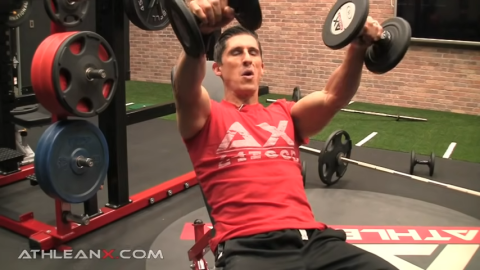
HOW TO DO THE FRONT DELT RAISE:
- To begin, adjust an incline bench to a 30-degree angle. In a seated position, hold a pair of dumbbells with an overhand grip.
- Execute a front raise by lifting the weights straight up until they’re at shoulder height. Ensure you’re using an overhand grip, with your palms facing the floor, slight bend in the elbows.
- This exercise can also be performed using a cable machine. If opting for the cable machine, ensure the workout bench is positioned correctly to provide a gentle pre-stretch to the front delt.
WHAT MAKES IT EFFECTIVE: Leaning back on a 30-degree angled workout bench helps provide a greater stretch on the front delt due to the arm’s extension behind your body. This will lead to greater shoulder strength and development.
CRUSH GRIP PRESS OUT

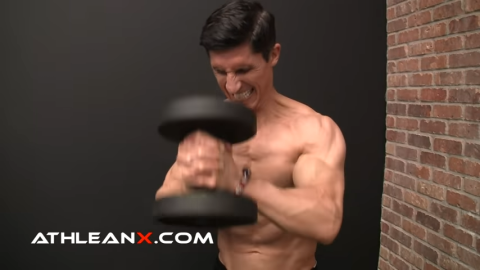
HOW TO DO THE CRUSH GRIP PRESS OUT:
- In a standing position with your feet hip-width apart and hold a dumbbell at chest height (the top of the dumbbells at shoulder height).
- Press the dumbbell directly out in front of you, focusing on the muscle contraction in the front of the shoulders.
- Pause then slowly return to the starting position.
WHAT MAKES IT EFFECTIVE: This is a tough one but it’s ideal for maximizing the muscle activation in the front of the shoulders.
DUMBBELL BUTTERFLY RAISE

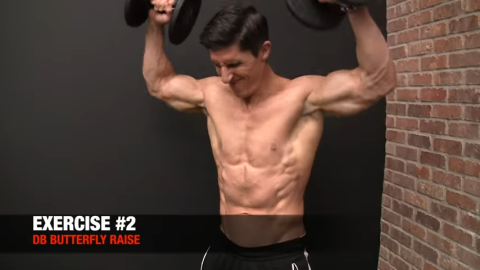
HOW TO DO THE DUMBBELL BUTTERFLY RAISE:
- Starting position is standing with feet shoulder width apart, holding a pair of dumbbells in an overhand position with the arms externally rotated.
- Use an underhand position and raise the dumbbells above shoulder height up and out to the side so that your elbows are at shoulder level.
- Pause and contract the middle deltoid then slowly lower the dumbbells back down.
WHAT MAKES IT EFFECTIVE: I’m a fan of this exercise because you get all the benefits of middle delt activation without putting too much strain and stress on the shoulder. This is possible by having internal rotation going on at the shoulder.
DUMBBELL HIP HUGGERS

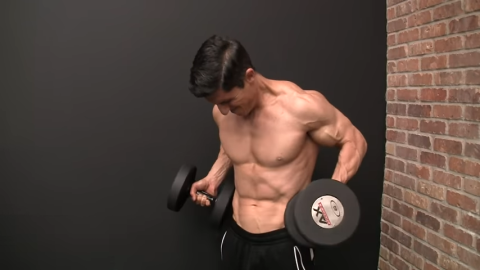
HOW TO DO DUMBBELL HIP HUGGERS:
- Start by standing feet shoulder width apart and hold a pair of dumbbells in your hands and let them hang down at your sides.
- Don’t forget, this isn’t like lifting weights straight up in front of you such as an Upright Row. Instead, you’ll turn your hands outward as you lift them up.
- Pull the weights up and back. Stop lifting when the weights are about as high as your belly button or just a bit higher.
WHAT MAKES IT EFFECTIVE: This position is good because it makes your arm move away from the center of your body while moving back behind your body.
UNDERHAND REAR DELT RAISE

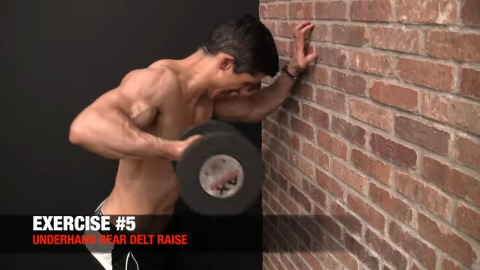
HOW TO DO THE UNDERHAND REAR DELT RAISE:
- The usual way of doing the Reverse Fly exercise doesn’t work the posterior deltoid muscle as effectively as it could. But, there’s a different way to use small weights that’s great for this.
- The important thing is to stretch your arm back behind your body as far as it can go.
- Guiding with your elbow, you should feel your shoulder blade move.
- Then, to really push it, twist your arm outwards. Contract rear delts and then slowly release.
WHAT MAKES IT EFFECTIVE: The contraction you get during this move is intense! In fact, you don’t even need to use a weight for this. If you try it right now – stand up, twist your hand outwards, and lift your arm up and back, you’ll feel the posterior muscles working harder than ever.
DUMBBELL SWIMMERS

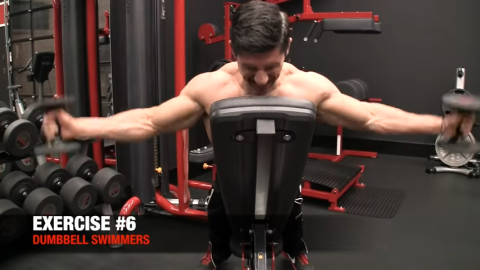
HOW TO DO DUMBBELL SWIMMERS:
- Start in a seated position on an incline bench with your chest resting on the bench, holding a dumbbell in each hand.
- Lift your arms up and out to your sides. You’ll notice the muscles in the middle of your shoulders are doing a lot of work.
- Then, swing your arms forward and let the front of your shoulders take over.
- Finally, move the dumbbells backward to ensure the back of your shoulders are also working. That range of motion is one rep!
WHAT MAKES IT EFFECTIVE: This exercise works all three parts of your shoulder muscles, and you don’t need heavy weights to feel it. What really matters is making sure all three parts of your shoulder muscles are working together, and this one move can do that. You don’t need heavy weights for this, maybe just lighter weights like 5 or 10 pounds tops. What’s important is what’s happening in your shoulders. There’s a lot happening, because the way you’re moving the weights around is working all three parts of your shoulder muscles at once.
4) WHAT ARE THE BEST DELT EXERCISES?
Guys, here’s the truth: Lifting really heavy weights isn’t the best way to build up your shoulders.
That’s because the shoulder muscles get a lot of help from other muscles in your upper body when you’re lifting heavier weights.
To lift those big weights, muscles in your arms, chest (pectoralis major), back, core, and legs all chip in. Plus, the momentum from the movement helps too.
In short, you can’t isolate the deltoid muscles with those bigger lifts.
That means the best way to build and develop your deltoids is to use lighter weights and intensely focus on the contraction.
Here are my picks for the best delt exercises that do just that. Just like before, I’ll go in order from the front of the shoulders to the rear deltoids.
OVERHEAD BAND PRESS

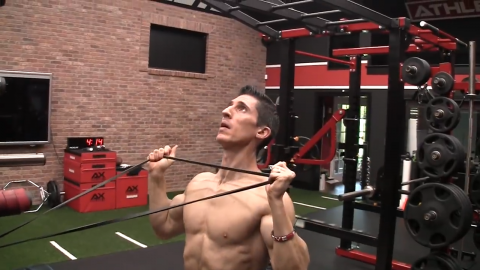
HOW TO DO THE OVERHEAD BAND PRESS:
- Attach the band to something that’s a bit lower than chest level.
- Grab the band with both hands and step back a couple of steps.
- Start to push upwards with both hands until they’re above your head.
- Aim for higher reps here, pausing for three seconds each time. It’s all about form and focus here so make sure to do each one slowly and carefully.
WHAT MAKES IT EFFECTIVE: The resistance band uses variable resistance, which means there’s a constant tension running through the target muscles. That’s a good thing! Just be sure to move slowly to intensify the contraction.
BARBELL OVERHEAD PRESS

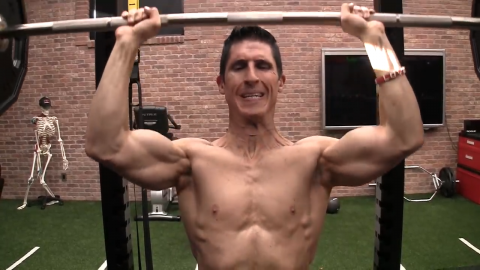
HOW TO DO THE BARBELL OVERHEAD PRESS:
- For this barbell raise exercise, traditional starting position is standing with feet hip width apart, holding the bar with an overhand grip and slightly wider grip than shoulder width, with your palms facing forward and at shoulder height.
- Push the bar up until your arms are stretched out above your head in overhead position, soft bend in the elbows.
- After that, bring your hands at shoulder level before starting again.
WHAT MAKES IT EFFECTIVE: The Barbell Overhead Press is my one exception to the rule. You can choose heavier weights for this exercise, ensuring you can build up your boulder shoulders. And while you won’t isolate the deltoids, you’ll certainly put them to work and build strong shoulders.
RELAY RAISES

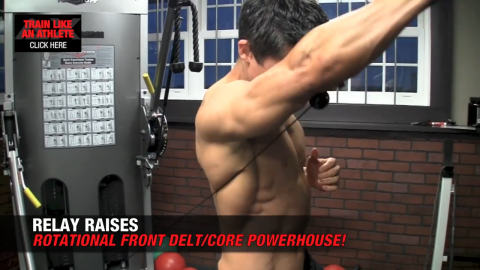
HOW TO DO RELAY RAISES:
- Start by standing with your feet as wide apart as your shoulders. Move one foot a bit in front of the other.
- You should be in front of a cable pulley machine and facing away from it.
- Grab the handle with one hand, with your palm facing forward.
- Use your shoulder to push forward, then slowly bring the weight back to the original position.
WHAT MAKES IT EFFECTIVE: The Relay Raise is one of my favorite deltoid exercises because it focuses on both the front delt muscle and rotational control. In other words, you’ll feel this one!
ZERO MOMENTUM SIDE LATERAL RAISE

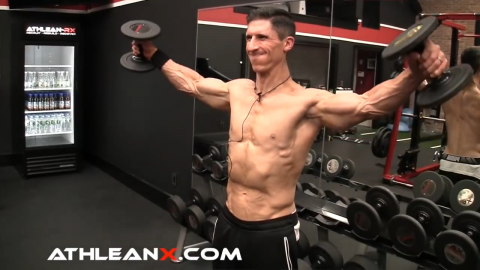
HOW TO DO THE ZERO MOMENTUM SIDE LATERAL RAISE:
- Stand up straight (don’t bend forward) and hold a pair of dumbbells with an overhand grip.
- Lift your arms straight out to the side with a slight bend in the elbows, and make sure you’re using the muscles on the side of your shoulders.
- On the first lift, stop when your arms are halfway up and pause before bringing them back down.
- On the next lift, raise your arms until they’re just above shoulder height.
- Focus on the intensity of the contraction during this exercise.
WHAT MAKES IT EFFECTIVE: By not using momentum, only your shoulder muscles are doing the work. That’s why you can use such light weights for this exercise and still feel like you’ve been using a ton of weight. This exercise is excellent for the lateral delts.
FACE PULLS


HOW TO DO FACE PULLS:
- To start the Cable Face Pull, attach a rope to a cable machine so it’s up high.
- Stand with one foot slightly in front of the other and hold onto the rope handles with your palms facing each other and thumbs pointing behind you.
- Twist your hands a little and start pulling the rope cable attachment down until your elbows are below your shoulders.
WHAT MAKES IT EFFECTIVE: The Face Pull is one of the best classic deltoid exercises because it helps to strengthen your rear delts and rotator cuff muscles while helping you avoid muscle imbalances and postural distortions. Be sure to include this one in every rear delt workout.
ONE-ARM REAR DELT ROW


HOW TO DO THE ONE-ARM REAR DELT ROW:
- Grab a dumbbell with an underhand grip and lean on a flat bench in a bent-over half-kneeling position.
- To target your rear delts, don’t keep your elbow close to your body. If your elbow stays close to your body, it’s better for the latissimus dorsi.
- Let your elbow move out to the side and as it does, lift and twist a bit to work out the back of your shoulder.
- Bring your lower arm to shoulder height, squeeze, and release.
WHAT MAKES IT EFFECTIVE: By making a simple tweak in the elbows, you provide yourself with an exercise that offers an intense contraction for the rear delts.
If you’re looking for more of the best deltoid exercises to add to your workouts, you can check out my article on Best Delt Exercises to see more examples.
5) WHAT IS THE BEST DUMBBELL DELTOIDS WORKOUT?
Let’s say you don’t have access to a cable machine, resistance bands, or a barbell, but you have plenty of dumbbells.
Can you still build a workout routine for your deltoid muscles with a set of dumbbells?
Absolutely! In fact, dumbbells are easily some of the best ways to target the shoulder muscles, especially the middle deltoids.
Here are my choices for the best dumbbell exercises for the deltoids:
DUMBBELL POWER CLEAN-OVER

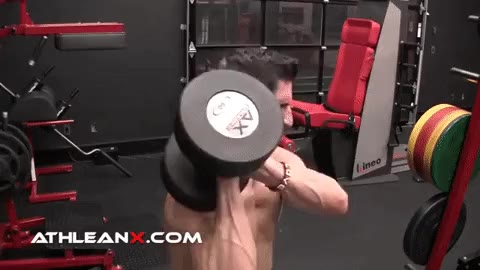
HOW TO DO THE DUMBBELL POWER CLEAN-OVER:
- The starting position for this exercise has you place a moderately heavy dumbbell on the floor.
- Explosively lift the dumbbell from the ground up to one shoulder, then move it across to the other shoulder, and then bring it back down.
- After that, do the same movement but in the opposite direction.
WHAT MAKES IT EFFECTIVE: This is a comprehensive deltoid exercise. This explosive motion taps into raw shoulder power and strength. The exercise also activates all three delt heads to help build shoulder strength.
DUMBBELL SHOULDER PRESS

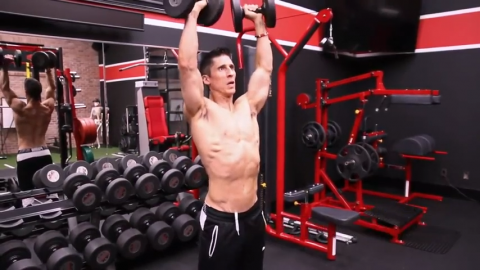
HOW TO DO THE DUMBBELL SHOULDER PRESS:
- To begin this dumbbell overhead shoulder press, traditional starting position is standing with your feet about shoulder-width apart and hold two dumbbells with palms facing each other at shoulder height.
- This will bring the elbows slightly forward, which is a good thing to reduce shoulder strain.
- Now, press both dumbbells up towards the ceiling until your arms are fully straightened in overhead position.
- Then, slowly bring the dumbbells back down to the starting position.
WHAT MAKES IT EFFECTIVE: This is a common shoulder exercise, but I add a tweak to it. This Dumbbell Shoulder Press helps you position your elbows in a safe and proper way for overhead pressing. By bringing your elbows slightly forward and away from your body, it reduces the risk of shoulder strain.
DUMBBELL PUSH PRESS

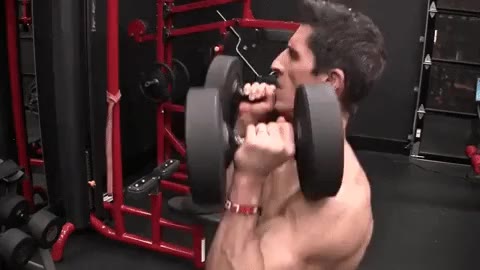
HOW TO DO THE DUMBBELL PUSH PRESS:
- To begin this basic shoulder exercise, stand with your feet about hip-width apart, and hold two dumbbells with palms facing each other at shoulder level.
- Now, push the dumbbells upwards with a sudden burst of energy until your arms are fully extended overhead.
- Lower the dumbbells back down and at the same time, push your hips back and squat down slightly. This will help drive momentum for the next rep.
- Keep repeating this exercise using controlled movements, but make sure to do it quickly and explosively.
WHAT MAKES IT EFFECTIVE: This dumbbell overhead push press lets you generate more power by using your legs to drive the movement from the ground up. By effectively engaging your hips, you can apply more force, strength, and speed to the exercise.
CHEAT LATERAL RAISE MECHANICAL DROP SET

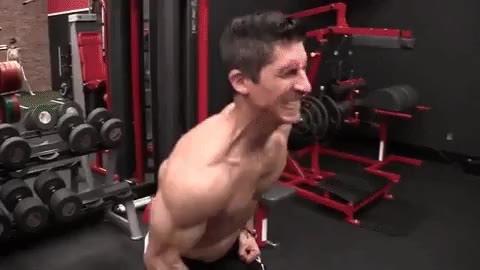
HOW TO DO THE CHEAT LATERAL RAISE MECHANICAL DROP SET:
- The initial position is to hold a dumbbell in one hand and slightly bend forward at the hips.
- Now, with a sudden burst of energy, lift the dumbbell out to the side, away from your body.
- Swing it up, but make sure to focus on the eccentric portion and control the weight as you bring it back down.
- Keep your elbow slightly bent throughout the entire movement.
WHAT MAKES IT EFFECTIVE: This exercise allows you to apply tension through failure, which is ideal for hypertrophy or muscle growth. Once you start to feel tired, you can switch to a lighter weight and continue with the Straight Dumbbell Lateral Raise until you reach the point of exhaustion.
FIXED ARM FRONT RAISE MECHANICAL DROP SET

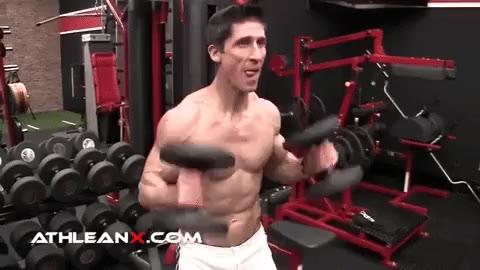
HOW TO DO THE FIXED ARM FRONT RAISE MECHANICAL DROP SET:
- Keep your arm bent at a 90-degree angle and lift it up in front of your body.
- Continue doing this movement even when it starts to feel challenging until you can’t do any more repetitions. Then, you can move on to a mechanical drop set.
- Start with a High Pull, then move to a Figure 8, and finally finish with a Dumbbell Press Out.
- Do each exercise until you reach failure.
WHAT MAKES IT EFFECTIVE: By doing a metabolic drop set with exercises like these, you cause lactic acid to build up in your muscles. This buildup of lactic acid creates stress on your muscles, which is another way to promote muscle growth and make them bigger and stronger.
If you’re looking for more great exercises to add to your dumbbell deltoid workouts, you can check out my article on Best Dumbbell Exercises for Shoulders to see more examples.
6) HOW TO DO DELTOID WORKOUTS AT HOME
For those guys who are just starting out or don’t have access to a full gym, these bodyweight exercises are for you.
Aside from the classic bodyweight exercise, I’m also going to throw in some resistance band exercises as I know a lot of you have a set at home.
As before, I’ve ordered the exercises to go from front to back, and from bodyweight to resistance band exercises.
BODYWEIGHT PUSH-AWAY

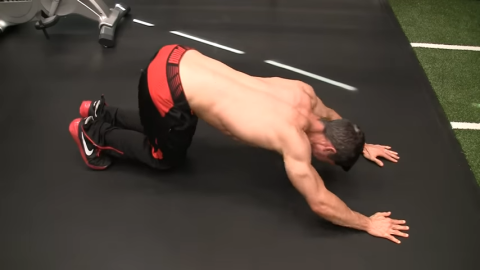
HOW TO DO THE BODYWEIGHT PUSH-AWAY:
- To do this exercise, start by getting into a plank position on the floor.
- However, instead of resting on your elbows, place your weight on your hands.
- Keep your elbows positioned in front of your body, just as if you were holding dumbbells or a barbell above your head. Your feet should be hip-width apart.
- Push your body away from the floor, concentrating on applying force and tension in your deltoids.
- Remember to keep your core muscles engaged by tightening them throughout the exercise.
WHAT MAKES IT EFFECTIVE: This movement provides all the benefits of an Overhead Press, but on the ground. Instead of pressing a weight, you’re pushing yourself up. Same shoulder muscle activation, different direction.
FRONT RAISE PULL APARTS

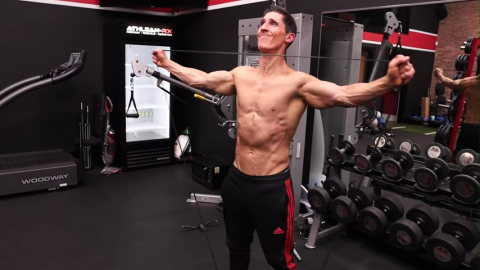
HOW TO DO FRONT RAISE PULL APARTS:
- To start, stand with a resistance band anchored below your feet.
- Hold the other end of the band in both hands. Begin by lifting the band upward with your arms in front of you, keeping a slight bend in your elbows.
- Once you reach shoulder height, spread your arms apart to stretch the band.
- Then, return to the starting position.
WHAT MAKES IT EFFECTIVE: The front raise targets the front delts, while the pull apart engages the medial and posterior delts, increasing time under tension.
BODYWEIGHT SIDE LATERAL RAISE

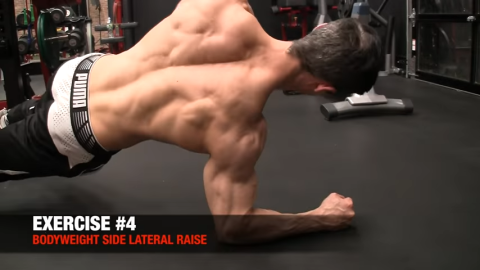
HOW TO DO THE BODYWEIGHT SIDE LATERAL RAISE:
- Get into a push-up position then move into a plank position on your forearms.
- Rotate your body while keeping one arm on the ground.
- Lift the other arm away from your torso to the side.
WHAT MAKES IT EFFECTIVE: This exercise involves using the concept of relative movement. It’s similar to a Dumbbell Side Lateral Raise where you lift your arm out to the side. Instead, you fix your arm in place and move your body away from it. This still works your shoulder muscles in the same way because it involves lifting your arm out to the side, specifically targeting the middle deltoid muscle. It’s a great way to activate and strengthen your shoulder muscles.
REVERSE IRON CROSS

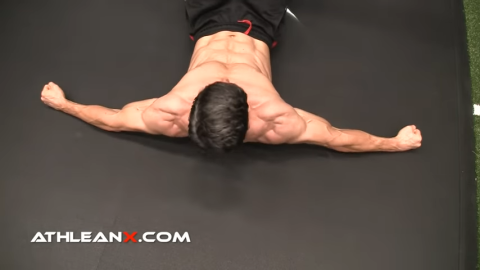
HOW TO DO THE REVERSE IRON CROSS:
- This is one of those posterior deltoid dumbbell exercises that looks simple, but it is actually pretty challenging. Start by getting into a position on the ground with your feet shoulder-width apart.
- The main objective is to exert maximum force by pushing through your closed fists into the ground.
- Try to generate as much pressure as possible.
- Additionally, aim to elevate yourself high enough so that your elbows are no longer touching the ground.
WHAT MAKES IT EFFECTIVE: When performing this exercise, you’ll notice the rear delt muscles working hard because you’re extending your arms behind your body. The benefit is that you can make the muscle contraction more challenging by holding the position for a couple of seconds before lowering yourself back down. This technique adds intensity to the exercise and can help enhance the effectiveness of targeting the rear delts.
BANDED REAR DELT PULL

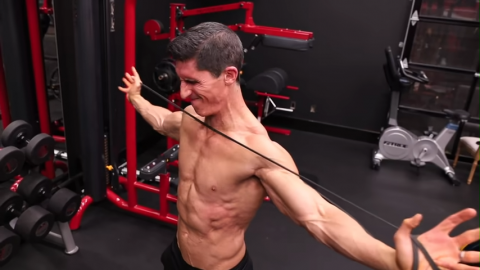
HOW TO DO THE BANDED REAR DELT PULL:
- To begin, hold a resistance band with your thumbs hooked onto the band.
- With your arms straight, pull the band back and apart, while simultaneously rotating your hands so that your thumbs point upward and your palms face away from you.
- As you pull the band apart, lead the movement with the back of your hands and focus on engaging the entire arm, then return to the original position.
WHAT MAKES IT EFFECTIVE: Maintaining straight arms throughout the exercise helps maintain constant tension on the rear deltoid muscle. This ensures that the rear deltoid is primarily engaged and doing most of the work during the movement.
Understanding the importance of well-developed, strong deltoids for your overall physique and training performance is essential. Deltoids are crucial joints that play a significant role in many exercises across various muscle groups.
Implement the methods and exercises suggested in this guide, and you’ll be amazed at the rapid progress in the development of your deltoid muscles.
For a comprehensive strategy aimed at enhancing lean muscle and strength throughout your body, explore our ATHLEAN-X programs. Pick the one that aligns best with your goals and available equipment.
DELTOID WORKOUTS FAQ
The best exercise for deltoids will focus on isolation movements for each individual head of the muscle. Daily shoulder training isn’t necessary with these moves. Instead, focus on shoulder day once or twice per week.
For the front deltoids, I would recommend exercises like the Front Delt Raise and the Overhead Band Press.
For the best lateral delt moves, I’d recommend the Dumbbell Butterfly Raise and the Side Lateral Raise to help build broad shoulders.
Finally, for the posterior deltoids, you should perform the Face Pull, One Arm Rear Delt Row, and Banded Rear Delt Pull.
To build well-developed shoulders, I’d recommend a balanced shoulder routine focusing on hitting each individual head of the deltoids muscle with separate isolation exercises. With that said, you can hit all three heads with exercises like the Crush Grip Press Out, Barbell Overhead Press, and Dumbbell Power Clean-Over. This combination of exercises will help you build well-developed shoulders
Yes, Push-Ups do build the deltoids but only the front deltoids will benefit from this exercise.
To build well-developed shoulders and ensure that your shoulder muscles are balanced, you can do Push-Ups to build your front delts but you should also do shoulder training that includes lateral delt exercises and rear delt movements.
To bulk up your deltoids and build strong shoulders, follow a balanced shoulder training program that includes delt-specific shoulder programming, good nutrition, and sufficient rest.
Pair compound shoulder exercises like the Overhead Presses with isolation exercises such as Lateral Raises and Front Raises to build beefy shoulders. This approach will ensure you hit all three parts of your deltoids.
Also, don’t forget about maintaining proper form to reduce risk of injury, fueling your body with protein-rich foods, and getting enough sleep to allow for muscle recovery and growth.
You can easily get bigger deltoids at home with a dedicated shoulder workout, no matter what type of equipment you have at your disposal.
If you only have dumbbells, try the following exercises in your shoulder programming to build beefy shoulders: Dumbbell Shoulder Press, Dumbbell Power Clean-Over, Dumbbell Push Press, and Lateral Raises.
If you have resistance bands, try doing these exercises: Front Raise Pull Aparts, and Banded Rear Delt Pull.
If you have no weights at home, you can use your bodyweight. Perform the Bodyweight Push-Away, Bodyweight Side Lateral Raise, and Reverse Iron Cross.
While you can use compound exercises during shoulder workouts, the best way to target each head of the deltoids is by adding isolation movements to your deltoid training.
Isolation exercises that work the anterior deltoids (front delts) include Front Raises, Crush Grip Press Outs, and Dumbbell Shoulder Presses.
To target the medial deltoids (middle delts), perform Lateral Raises and Dumbbell Hip Huggers.
Finally, to activate the posterior deltoids (rear delts), do some Underhand Rear Delt Raises and Face Pulls.
The deltoid is a single muscle with three parts: anterior (front), medial (middle), and posterior (rear).
The anterior deltoid plays a key role in forward arm movements and inward rotation of the arm. It assists in actions such as lifting an object directly in front of you or swinging your arm forward during a run.
The lateral deltoid primarily aids in lifting the arm out to the side like when you’re perform Lateral Raises or signaling while riding a bicycle.
The posterior deltoid contributes to backward movements and outward rotation of the arm. It comes into play when you're pulling something towards you, doing Reverse Flyes, or swinging your arm backward during a run.
REFERENCES
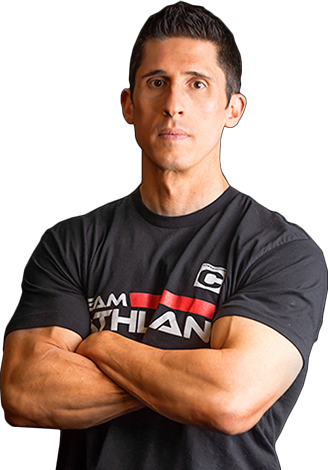
Jeff Cavaliere M.S.P.T, CSCS
Jeff Cavaliere is a Physical Therapist, Strength Coach and creator of the ATHLEAN-X Training Programs and ATHLEAN-Rx Supplements. He has a Masters in Physical Therapy (MSPT) and has worked as Head Physical Therapist for the New York Mets, as well as training many elite professional athletes in Major League Baseball, NFL, MMA and professional wrestling. His programs produce “next level” achievements in muscle size, strength and performance for professional athletes and anyone looking to build a muscular athletic physique.
